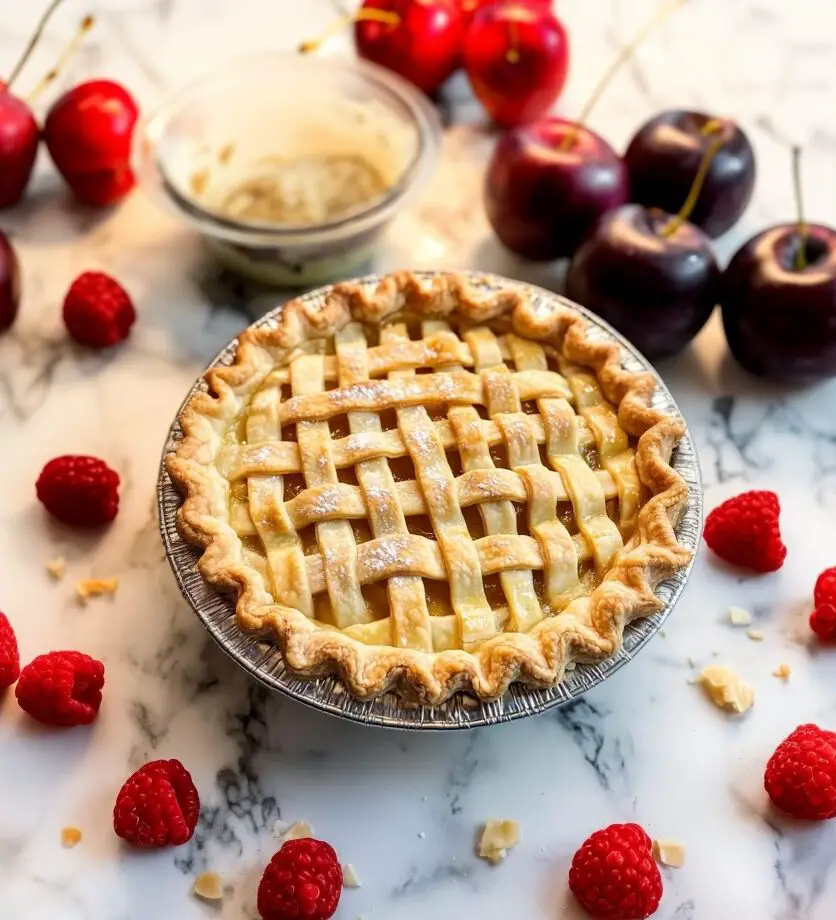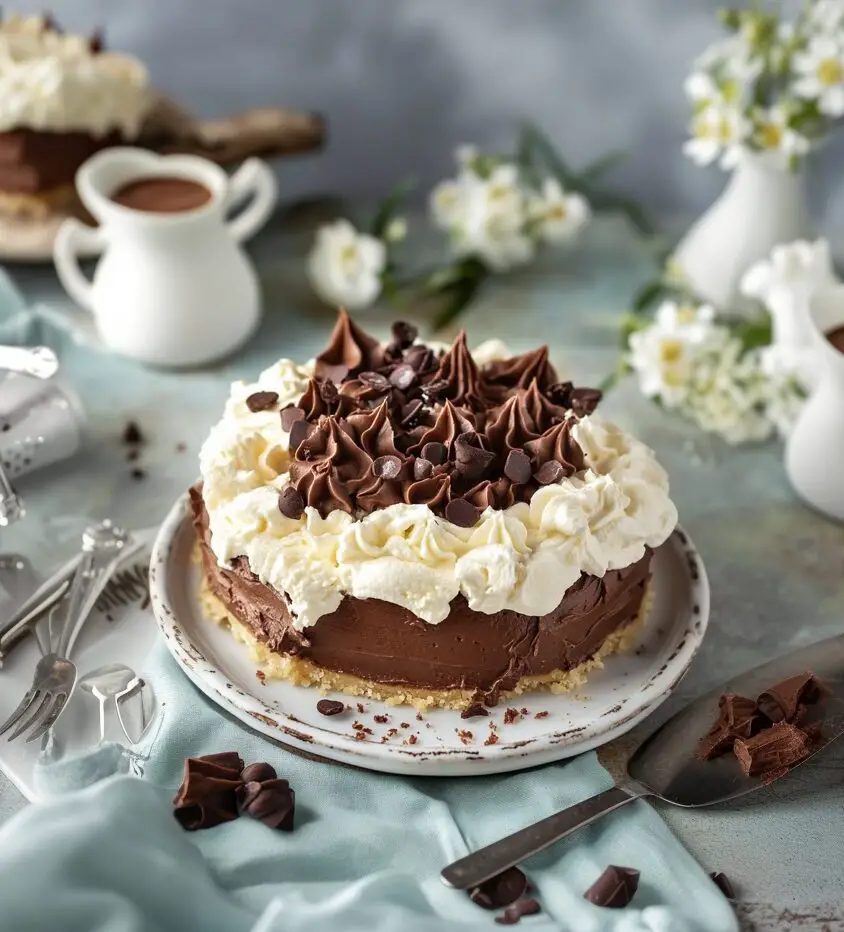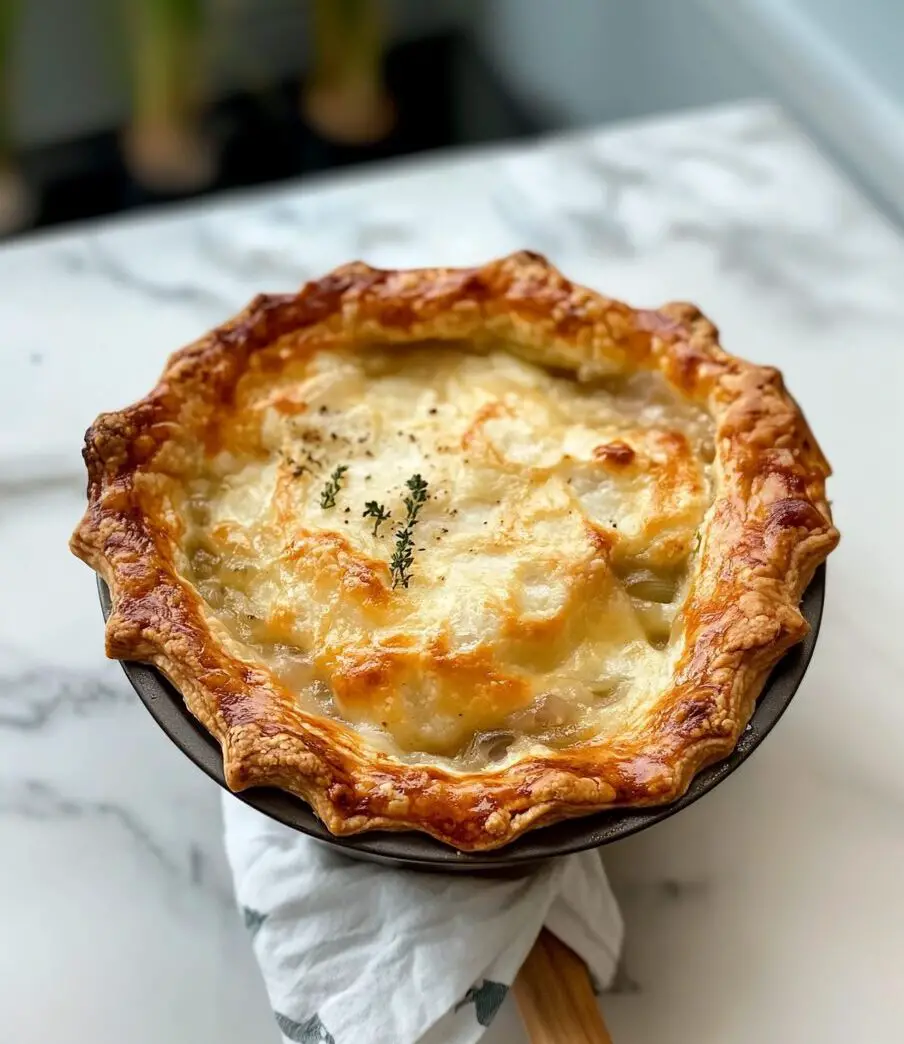This homemade buttery flaky pie crust is a foundational recipe for both sweet and savory pies. Its rich flavor and tender, flaky texture make it an essential component for classic desserts like apple pie, as well as savory dishes like quiche.
Full Recipe:
Ingredients
- 2½ cups (315g) all-purpose flour
- 1 teaspoon salt
- 1 tablespoon granulated sugar
- 1 cup (2 sticks; 230g) unsalted butter, cold and cut into cubes
- ½ cup (120ml) ice water
Directions
- In a large bowl, combine the flour, salt, and sugar.
- Add the cold, cubed butter to the flour mixture. Using a pastry cutter or two forks, cut the butter into the mixture until it resembles coarse crumbs with pea-sized bits of butter.
- Gradually add the ice water, one tablespoon at a time, mixing until the dough begins to clump together.
- Transfer the dough onto a floured surface and divide it in half. Shape each half into a disc, wrap tightly in plastic wrap, and refrigerate for at least 2 hours.
- When ready to use, roll out the dough on a lightly floured surface to fit your pie dish.
Nutritional Facts (per serving, based on 1/8 of the recipe)
- Calories: 320
- Total Fat: 22g
- Saturated Fat: 14g
- Cholesterol: 60mg
- Sodium: 200mg
- Total Carbohydrates: 27g
- Dietary Fiber: 1g
- Sugars: 1g
- Protein: 3g
Why Homemade Is Better: The Benefits of Making Pie Crust from Scratch
There are several reasons why making pie crust from scratch is worth the effort. The most notable advantage is taste. Store-bought pie crusts, while convenient, often lack the richness and flavor that comes from using fresh, high-quality ingredients. Homemade pie crust offers a deep, buttery flavor that is unmatched by pre-packaged options. When you prepare the dough yourself, you have complete control over the ingredients, ensuring that the crust is made with real butter and no artificial additives or preservatives.
Another benefit of making your own pie crust is texture. Store-bought pie crusts can be overly thick or dry, resulting in a lackluster base for your filling. A homemade crust, on the other hand, creates a beautifully tender yet crisp layer that complements the filling perfectly. When baked, it will develop a light, flaky texture that melts in your mouth. The addition of cold butter and the careful handling of the dough creates layers that puff up during baking, giving your crust a delicate, airy crunch.
Additionally, homemade pie crust allows you to customize the flavor and texture to suit your preferences. You can experiment with different types of flour, adjust the amount of butter, or even incorporate herbs or spices for a unique twist. You also have the option of making the dough ahead of time, which is a huge advantage when preparing for a busy baking session or when you want to save time on the day you’re baking the pie.
Understanding the Science of Pie Crusts
To achieve the perfect pie crust, it’s important to understand the basic science behind it. A flaky pie crust is created when cold fat (usually butter) is incorporated into the flour. As the dough bakes, the fat melts, creating pockets of air that result in a light, flaky texture. The key to achieving the right flakiness is to handle the dough as little as possible. Overworking the dough will develop the gluten in the flour, leading to a tough crust. The dough should be mixed just enough to bring it together, and then gently pressed into shape.
The ratio of fat to flour is another important aspect of pie crust making. The more fat you incorporate, the more tender and flaky the crust will be. This is why butter is often the fat of choice for pie crusts—it provides the rich flavor and texture that make homemade crusts so irresistible. However, it’s important to not use too much butter, as this can make the dough too greasy, which will cause it to lose its structure during baking.
The addition of ice water to the dough helps to hydrate the flour without activating the gluten too much. The cold water also ensures that the fat remains firm throughout the dough-making process. This is why it’s crucial to keep the ingredients cold, from the butter to the water, as it helps to achieve the desired flakiness.
Tips for Perfecting Your Pie Crust
While making pie crust is a relatively simple process, there are a few tips and tricks that can help ensure your success. First and foremost, use cold ingredients. Cold butter is essential for creating the flaky texture that pie crusts are known for. You can even chill the flour and bowl in the refrigerator for 10-15 minutes before starting to make the dough. This will help keep the dough cold and ensure that the butter stays firm while you work it into the flour.
It’s also important to handle the dough as little as possible. After mixing the dough, gently press it into a disc shape, wrap it in plastic wrap, and refrigerate it for at least 2 hours. Chilling the dough helps to relax the gluten, making it easier to roll out and preventing shrinkage during baking. You can even prepare the dough a day ahead and store it in the fridge, allowing the flavors to develop further.
When rolling out the dough, be sure to work on a floured surface and use a rolling pin to evenly roll the dough into a circle. If the dough starts to stick, add a little more flour to your work surface or rolling pin. If the dough cracks or tears while you’re working with it, don’t worry—simply patch it together with your fingers, as it’s important not to over-handle the dough.
Making the Perfect Pie Crust for Different Types of Pies
Different types of pies require different approaches when it comes to the crust. For sweet pies, such as fruit pies, cream pies, or custard pies, a buttery, flaky crust pairs perfectly with the filling. For savory pies, such as quiches or pot pies, the same pie crust works well, though you might consider adding a pinch of salt or dried herbs to the dough for extra flavor.
If you’re making a double-crust pie, such as a classic apple pie, you’ll need two discs of dough—one for the bottom and one for the top. When preparing the bottom crust, be sure to press the dough evenly into the pie dish to avoid air pockets, which can lead to a soggy crust. If you’re making a pie with a custard filling, such as a pumpkin pie, it’s essential to pre-bake (or “blind bake”) the crust to ensure it doesn’t become soggy while baking with the filling.
For decorative pies, such as lattice pies or pies with intricate crust designs, the dough should be rolled out slightly thinner to create a more delicate, artistic appearance. You can use cookie cutters to create fun shapes for the top crust or use a knife to create a lattice pattern. The options are endless, and you can truly get creative with how you present your pie.
Troubleshooting Common Pie Crust Issues
While homemade pie crusts are generally simple to make, there are a few common issues that bakers face. One issue is shrinkage. If your pie crust shrinks during baking, it’s usually because the dough was not chilled enough before baking or the dough was overworked. To prevent this, be sure to refrigerate the dough for the recommended time and avoid handling it too much.
Conclusion
The homemade buttery flaky pie crust is a baking essential that elevates any pie to new heights. Whether you’re baking a fruit-filled dessert pie or a savory quiche, a flaky, buttery crust provides the perfect balance of flavor and texture. While making pie crust from scratch may seem like a daunting task, with the right techniques and a little patience, anyone can master it.








